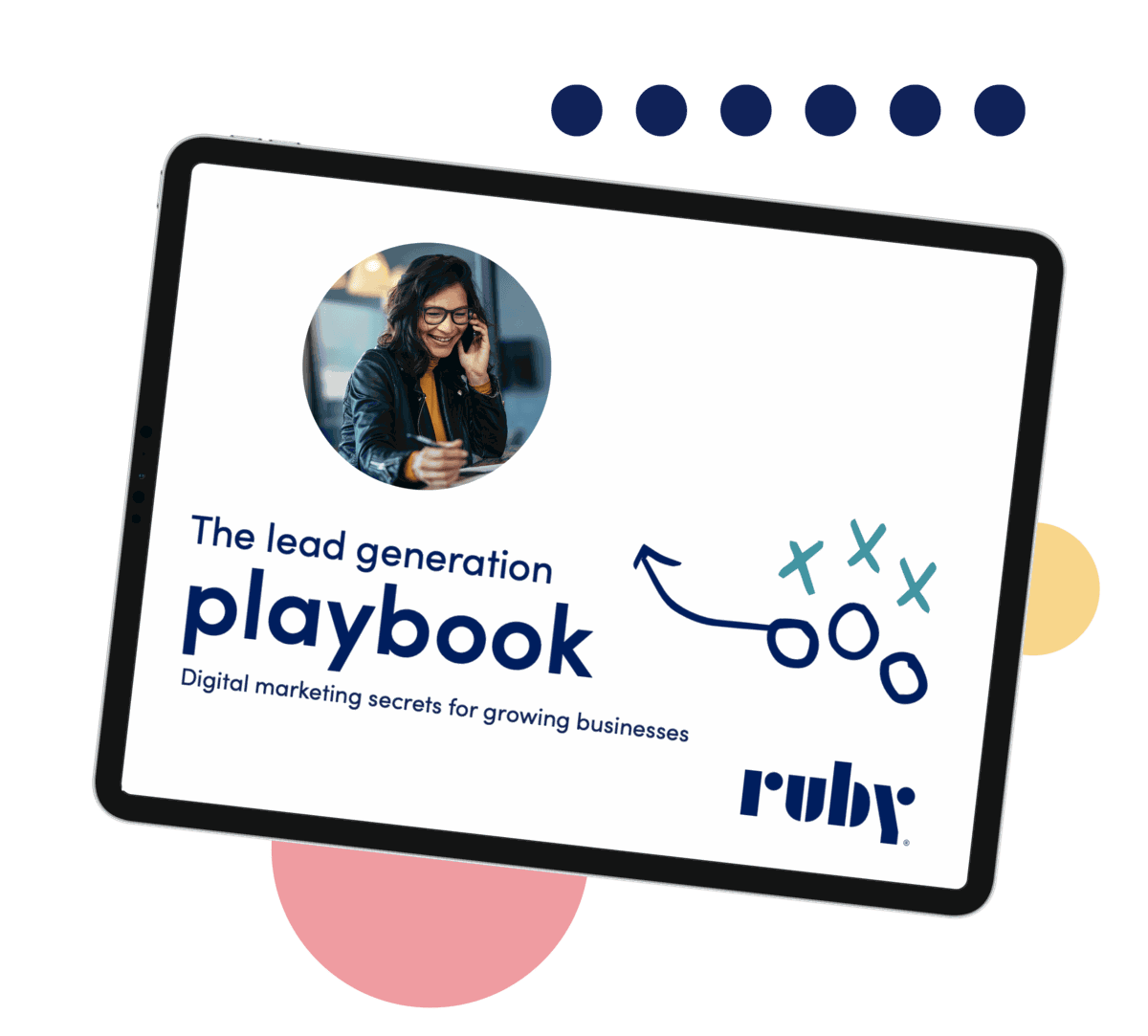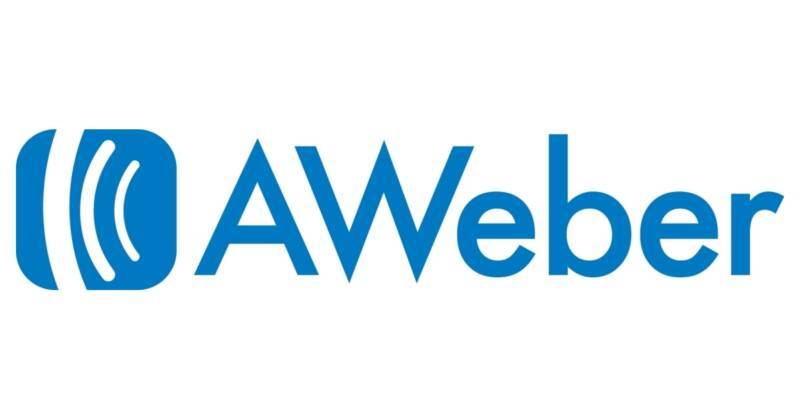What is lead generation—and why does it matter?
So, you’ve worked hard to create an exceptional product or service. Great work! Now it’s time to sit back and wait for the profits to start rolling in, right?
Unfortunately, no.
It would be great if customers handed over their money the moment they heard about your business (understatement of the century). However, that’s not usually how it goes down. Turning a visitor into a buyer is an art and a science—and it all starts with getting their attention.
That’s what lead generation is: the process of attracting potential buyers and capturing their interest. The goal is to use your various marketing channels to bring leads to your business and incentivize them to share key information, such as their contact details, with you.
Once you’ve gathered this valuable information, you and your team will be in a much better position to translate that initial interest into a sale, and hopefully, a long-term relationship between your business and the customer or client.
How lead generation fits into your marketing and sales strategies
Generating leads is essential to business growth. After all, more buyers = bigger profits = additional opportunities to grow your business.
But growth isn’t the goal for every business out there. If you operate a lifestyle enterprise that provides you with a fixed income, lead generation may strike you as being bad for business. When you consider that the average operation loses 15% of its customers each year, however, it’s clear bringing in more leads is as essential to maintaining profits as growing them.
Lead generation doesn’t just help you reach more potential clients—it helps you build brand visibility, grow your social media following, connect with new partners, collect more customer reviews, and learn more about your ideal audience.
For all these reasons, “setting and forgetting” your lead generation strategy isn’t viable if you’re at all invested in the health of your business (which, if you’ve downloaded this guide, we’re betting you are!). Your marketing and sales functions will need to work together in harmony so your business can easily qualify leads, score prospects, and determine how and when to reach out to every new contact.
Of course, you’ll need the right strategies in hand before getting started. We’ll get to those in a bit, but first, let’s take a closer look at the people your business will be guiding through the almighty funnel.
Discover how to identify leads
Business leads are mysterious by nature. They’re potential new customers or clients—that much is clear—but the rest is enigmatic: Who are they? Where do they come from? How can you attract them and convert them into buyers?
Truth be told, leads only seem mysterious. To begin with, you can safely assume your leads are humans—real humans, with real stories, coming to you with real problems that only businesses like yours can solve. Understanding each human’s story is the key to effectively identifying each lead and guiding them through your marketing and sales efforts.
Identifying and categorizing leads
Before we jump in, it’s helpful to first learn the lead lingo (try saying that five times fast.)
- A lead is someone who, on behalf of themselves or their company, may one day purchase a product or service from your business.
- A prospect is the middle step between a lead and a customer—someone who’s shown definite interest but hasn’t fully committed to buying something yet.
- A qualified lead has signaled their interest through a direct conversation or interaction with you or someone on your team.

Some businesses categorize leads by assigning them a temperature. Others imagine the capture process as a funnel. Both are mostly interchangeable, and we’ll be using each throughout this guide. As for which one your business should use, well, dealer’s choice!
-
Cold leads/Top of funnel:are people who might have a need for your product or service but haven’t yet shown any interest.
-
Warm leads/Middle of funnel:are interested but still need to be convinced.
-
Hot leads/Bottom of funnel:are ready or almost ready to buy.
How to approach each type of lead
A one-size-fits-most approach to lead conversion doesn’t work for one very important reason: every lead has different needs. Not only that, their expectations shift as they move further down the funnel.
Meeting and exceeding these ever-changing expectations requires a personalized approach that can be hard for first-time—or even one hundredth-time—salespeople to master. Fortunately, we’ve got a few tips to help guide you.
- Let’s start with someone who’s almost ready to buy. How do we convert them into a customer? By demonstrating value. Keep in mind that they still might be shopping around and remind them (again) that your product or service is the only one that is right for their specific situation.
- Next, let’s talk about the prospect who is still on the fence. How can you pique their interest? By framing the conversation around their needs. Your goal should be to get them engaged, and there’s no better way to do that than by asking them questions—not to mention that this lets you learn even more about them.
- Finally, we come to our cold lead. We don’t know much about this person at all—what they’re looking for, what their needs are, or even if they’re interested in making a purchase. How in the heck, then, do we take them from total stranger to satisfied customer or client? By putting our best foot forward. Your business only gets one chance at a first impression, so it’s important to gently communicate your unique value propositions through whichever channel you’re using to interact with them.
Ready to learn more?
At this point, we’ve talked about the who, what, and why of lead generation. All that’s left is how to put an effective strategy in place that brings in more prospects—and eventually, customers or clients—for your business.
The power of content marketing
By Gabe Freis, Content Writer at Ruby
You’ve likely been told that effective content marketing is essential to building your online presence. That’s genuinely helpful advice—until you consider many people don’t know what content marketing is, or how you define “effective” content.
The good news is that if you’ve ever looked up a recipe, followed a social media account, or watched a how-to video on getting toothpaste out of your hair (don’t ask), then you’ve interacted with successful content. All you need now is the right know-how to start creating lead-winning content for your own business.
What makes content “king?”
If you’re new to the marketing game, you might wonder why content is “king” over, say, advertising. After all, catchy jingles and memorable commercials have worked for businesses for years, right?
Well, yes. But when it comes to attracting online leads, there’s one very important distinction to keep in mind:
Ads find people. People find content.
Content marketing vs. advertising
What’s the difference between a piece of “content” and an ad, anyway? While there’s overlap in terms of their physical characteristics (i.e., both use words and/or images), there’s an important distinction in how they’re used and distributed. Ads are paid media—you have to give someone money to place an ad somewhere, such as on a billboard or at the top of a search engine results page. Content marketing is an organic strategy, meaning it shows up in unpaid media channels such as blogs and search engine results beneath the ads.
People are constantly on the hunt for answers. They watch videos on sink repair; they read blogs filled with legal advice; they download ebooks about lead generation.
Content marketing has the power to help your business connect with prospects at little to no cost.
But content marketing isn’t just a more cost-effective way to attract and engage with more leads. It’s also your key to building better connections with them. That’s because your content is wholly, completely, 100% yours to own.
Your website and social channels are springboards for unique insights, one-of-a-kind stories, and helpful tips—all of which serve to educate and empower your audience. Your business has valuable knowledge and sharing it with the people you serve is one of the best ways to generate relational currency while guiding the conversation around your business.
How to create high-converting content
1. Be bold.
Too many businesses phone things in by following templates and formulas that make their lives easier—but do little to keep their audience’s attention.
“52% of people think that most content is overly commercial, and 48% feel that it’s too long, boring, and basic.”
Blue Fountain Media
Your customers or clients appreciate when you invest time and effort into your work. Content is no different. You can bet that when you take risks and put your heart into everything you publish, your audience will take notice.
2. Make it accessible.
Authenticity is in short supply across most online channels. Instead of using stock imagery that people will scroll past, add in a human element by including photos of your team or projects you’ve been working on.
3. Find your niche.
Play around with different formats and platforms to figure out what’s working (and what’s not.) Once you’ve identified the areas where your content shines, it won’t be too long before people see you as the go-to resource to whatever it is that your business specializes in.
4. Inspire action.
Instead of churning out massive amounts of low-quality content, take your time to provide your audience with interesting and actionable information that leaves a strong impression. Remember, the goal should always be for people to bookmark (or ideally, share) your content!
5. Be aware of your limits.
There is no reason why you must publish a new blog post three times a week or have a new social media post go live every single day. Excellent content takes time to craft, so make sure you’re setting aside enough time to prioritize quality over quantity.
Knowing what effective content marketing looks like is half the battle. Actually, it’s probably a bit more. I’d say 3/4 at least—but then again, I’m a content marketer.
And that’s an important point—for as powerful as content marketing can be, keep in mind that it’s just one lead generation strategy among many. Let’s look at some more, so you can determine what works best for your specific industry and how to execute your lead generation goals successfully.
Build relationships with email
By AWeber
Email marketing is one of the oldest digital lead generation tools, and it continues to be an essential part of any marketing strategy. It’s effective, easy to automate, entirely controlled by you, and gives you access to a lead’s inbox: something almost everyone checks every day.
Email marketing helps build relationships and trust with your audience—and when done correctly, drives more new leads to convert into clients or customers. But it requires a delicate touch. If done incorrectly, email marketing can hurt your business’s brand and land you in spam filters.
Don’t fret! We’re here to teach you the right way to market to leads via email.
Step 1: Capturing email addresses
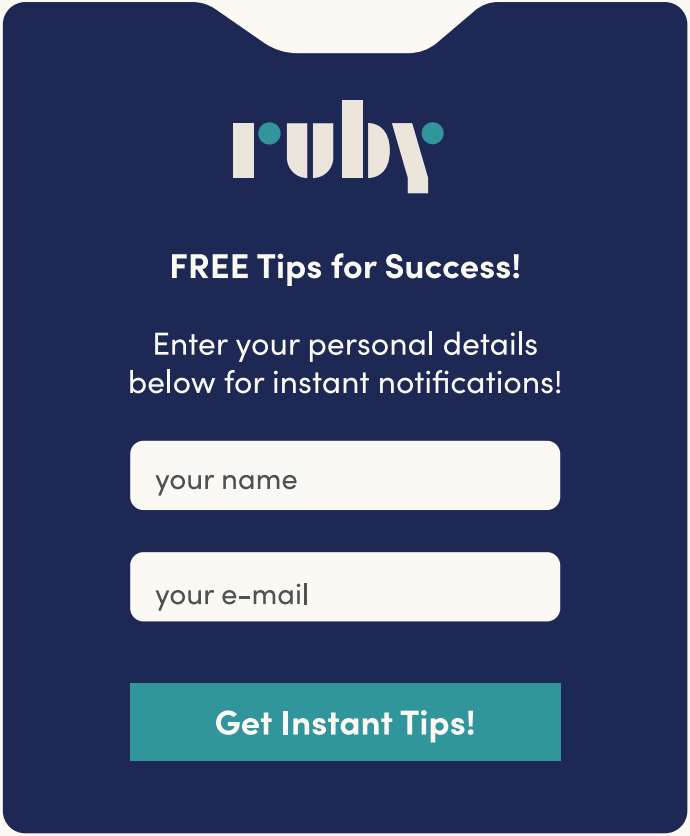
It may seem obvious, but the success of email marketing requires capturing the lead’s email in the first place.
You can capture new leads’ emails on your website, at a conference, or on social media with an opt-in form. On your form, always ask for a name and email address, plus any additional information you’d need off the top (such as a lead’s location or interests).
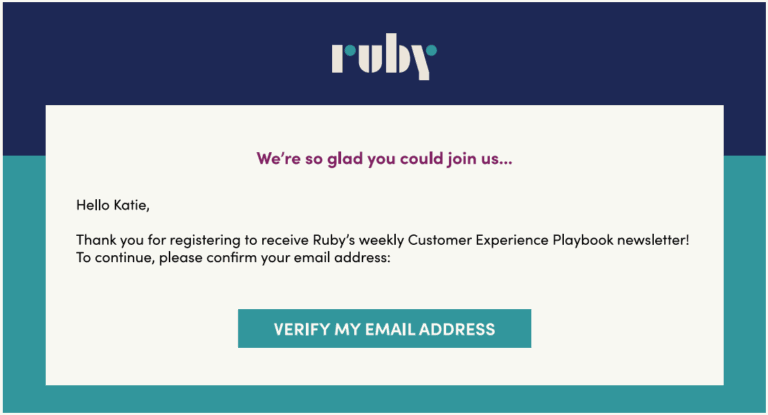
Once a lead has filled out your form, you need to email them to confirm they signed up. This confirmation email is called a “double opt-in,” and it’s essential for a few reasons:
- Trust:You ensure the prospect is interested in receiving your emails.
- Deliverability:Double opt-in minimizes the chances your emails will get caught in spam filters or blocked altogether.
- A clean email list:You’ll send emails to engaged leads who are most likely to purchase from you (email for email’s sake is pointless unless there’s a chance for a conversion).
In your confirmation email, make sure you set expectations appropriately. Let your leads know what types of emails you’ll be sending them and how often.
Which leads us to another point…
Step 2: Driving engagement
What types of emails should you send to leads? Certainly not just a sales pitch every now and then. Try sending these emails, known for creating engaged audiences:
- Educational newsletters: Offer useful tips and tricks from your area of expertise.
- Process explanation: What’s it going to look like when they work with you?
Social proof: Share testimonials and success stories from clients or customers. - Industry news: What do you keep up on that those leads might want to know?
- Feedback requests: What do they want to hear from you?
- Customer challenges: Encourage leads to complete a challenge (e.g., “Create a business plan in two weeks!” or “Wildfire-proof your home in 7 days!”
When each lead signs up, it’s important to send them a few “essentials” emails, also known as a welcome email series. Every person will receive the same emails, but they’ll sign up at different times, so it’s best to automate your welcome series.
Set up an automated drip campaign in your email service provider. The drip will “trigger” when someone signs up for your list. You can send them the first email immediately and then set the campaign to wait a day or two before sending subsequent emails.
A drip campaign may sound intimidating, but email software makes it easy for the non-technical business owner. That said, don’t be afraid to ask for help. Email marketing can be easy and essential to capturing leads and driving conversions. If you hit a snag, search online for video tutorials, blog posts, and other resources that can help you achieve electronic mail success. Good luck!
The power of social media
By Melissa Barker, Marketing Consultant and Founder of Strategy Now LLC
Not much of a social butterfly? If you can’t tell the difference between a pound sign and a hashtag, don’t worry, you’re not alone.
Many businesses feel overwhelmed by the prospect of getting active social media. As a result, they hesitate to use this important communication channel and miss out on significant opportunities to connect with their audiences.
The key to overcoming this hurdle and using social media effectively is to focus and think strategically. It starts with determining which platform or platforms are right for you and the people you intend to reach.
Here are four crucial considerations when selecting social media platforms as a small business:
Your product or service: Do you have a physical product that lends itself best to photos, or are you a service-based business? If you have a product-based business, choose a platform that favors image or video sharing, like Instagram or TikTok.
B2C (business-to-consumer) vs. B2B (businesses-to-business): Knowing who your ideal buyer is will help inform which social networks are best suited for lead generation for your business. For B2C, try Facebook, Instagram, Twitter, or TikTok. For B2B, consider LinkedIn and Twitter.
Your target audience: Beyond B2C or B2B, know your specific target audience or target personas. Who is your typical buyer, and what do they like? Use your current customer list to determine these answers. You can search online for which demographics spend the most time on which social networks.
Your resources: How much time can you dedicate to social media marketing? Are you skilled at writing, photography, or video editing? Once you decide on the medium based on your product or service, decide to either outsource content creation or pick a medium you are skilled at creating content for.
I always recommend setting up profiles on all the social networks you believe you will use to claim your business’s unique name. However, only invest in building your presence on 1-2 social media platforms at first to avoid being spread too thin.
Converting followers and engagement into leads
To convert your followers into leads, you’ll need to provide them with two things: opportunities to give you their contact information and a compelling offer. This starts with including strong calls to action (CTAs) in your posts that encourage followers to visit your website. Once there, they’ll be asked to fill out a lead capture form in exchange for your offer.
Step 1: Set up lead capture forms. Examples of places to use forms include:
- Your email newsletter. Provide an incentive for those who give their contact information.
- Downloadables (e.g., ebooks, white papers) that can be “gated” behind a form and requires information such as a name or email address to gain access.
- Digital events (such as webinars) that require registration.
For more information about forms, see the chapters on email newsletters and websites.
Step 2: Promote lead capture pages on your social media page. Aim to have 30% of your posts be promotional (of your product or service). These posts should include your lead-capturing CTAs. The other 70% of your content should be educational and trust-building.
Step 3: Consider campaigns. Spend 1-3 weeks promoting one lead capture with a compelling offer behind it. Giveaways and freebies are a great way to begin capturing leads.
Starting with social media advertising
When investing actual dollars into social media advertising, begin with a “Sponsored Post” or “Promoted Post,” depending on which social media platform you use. Before diving into the complexity of ad campaigns, try expanding your post reach by promoting a single post. Follow these steps to find the best promotion method for your business.
Step 1: Determine your goal. Is it to get registrations for an event or downloads of an eBook?
Step 2: Create your social media post with a short description and clear CTA to register or download.
Step 3: Promote your post.
- Set a budget. A good starting point is $100-$300.
- Identify your target audience demographics based on location, job role or keywords, etc.
Step 4: Review the results. How many clicks and leads did you end with? What was your cost per click (CPC) and cost per lead (CPL)? A successful CPC or CPL will vary depending on the revenue potential from a lead. If you have a high-cost or high-ticket offer, you can afford to spend more per click or lead. If you have a less expensive product or service, you may only want to pay a few dollars because the return potential is less per lead.
Speaking of DMAs (digital marketing acronyms…a term we may have invented), let’s discuss another important one: PPC.
Set yourself up for pay-per-click (PPC) success
By Austin Heineman, Copywriter at RLM
Every day, nearly one-third of US consumers search for local businesses online. As this shift online continues, it’s increasingly important for your business to have a strong digital presence.
You likely already have a website and one or more social media accounts, but if you want to get in front of as many potential customers or clients as possible, consider investing in a PPC (pay-per-click) campaign. Here’s how to set yourself up for success:
Do your (keyword) research.
Identifying relevant keywords is the first step in improving your site’s ranking, both organically and through paid efforts. Compile a list with a quick brainstorming session. What are your potential customers typing into the search bar?
Get the most out of your website.
You’ll want to ensure your website is optimized, both for search traffic and engagement, before spending money on a PPC campaign. After all, this is where your potential customers will end up after they click on your ad.
Stand out to Google and Bing by adding relevant keywords to your headers. This helps your site rank higher in search results pages and makes a user’s jump from ad to website as smooth and successful as possible.
To go even further, consider adding a blog to your site. A library of a few industry-related articles that you add to on a regular basis not only gives you more opportunities to add keywords, but also shows your passion and expertise in your trade. When searchers engage with your blog, they’ll begin to build trust in your business before you ever even speak with them.
Optimize for local searches.
The internet gives you the ability to target people across the world, but not all searchers are the same. A law firm in Milwaukee, for instance, isn’t going to benefit from appearing in search results in Jacksonville.
Direct your efforts towards targeting people in your geographic area. Go back to your list of keywords and add localized phrases, like “best law firms near me” or “best local dentists.”
There are several ways to indicate where your business is located. Google My Business offers a simple form you can complete that increases your visibility and ensures that your business shows up consistently across the web. Implementing an easy-to-read contact page on your website that lists your phone number, hours, and address also helps. When the search engines know where you’re located, they’ll put you in front of people in your area searching for your service.
Don’t forget about mobile.
62% of smartphone users are more likely to contact a local business if the business has a mobile-friendly website. Search engines also pay attention to this—and they’ve already begun to penalize websites that lack mobile-friendly user experiences.
Fortunately, this is an easy issue to identify. Simply browsing your site on your personal mobile device helps highlight potential problems, so you can make any display or functionality changes before spending from your ad budget.
Identify your key performance indicators.
Last, keep an eye on what’s working and what isn’t by continually checking your stats. Numbers such as your bounce rate, clickthrough rate (CTR), and cost per lead (CPL) are great indicators of your campaign performance.
For more information about metrics, see the chapters on social media and SEO.
Getting started with search engine optimization (SEO)
By DSG
The estimated number of web pages in the Google index is anywhere between 15 and 70 billion. That means your website (and by extension, your business) is a teensy tiny needle in a mind-bogglingly large haystack.
The first step towards helping consumers find you in this digital maze is by implementing a strategic search engine optimization (SEO) plan. After all, when more people can find you, more people will do business with you! However, SEO can be complicated to understand and seemingly has a language all its own.
The good news is you don’t need to face SEO alone. Here are a few tips for getting started with an SEO plan and finding the right vendor for your business:
Getting started
First, secure your digital business information by creating, claiming, and optimizing your online listings. “Listings” are profiles across the ecosystem of search engines, online directories, navigation apps, and social platforms—including sites like Google My Business, Yelp, Facebook, Apple Maps, and dozens more. (Keep in mind that online listings can get as much—if not more—traffic than your website itself, so make sure they’re accurate and consistent.)
Next, it’s time to complete an audit of your website. This audit serves to get a baseline understanding of the current state of your website, so you can efficiently communicate your goals and vision to an outside agency or professional. Consider your website’s content:
- Is it accurate and up to date?
- Are all your links working and images appearing?
- Is there content that reflects all of your products and services?
- Is there anything such as additional pages, videos, or blogs you’re planning to add?
Finding the right SEO partner
It’s important to thoroughly examine your options before deciding on an SEO partner. Never settle for the first vendor you find—it’s always worthwhile to shop around with a few different vendors.
Start by asking targeted questions:
1. How will you quantify success? This is possibly the most important question to ask potential SEO partners. A legitimate SEO agency should be able to set clear expectations of what key performance indicators they plan to report on in order to determine the success of your campaigns. Examples of KPIs may include:
- Keyword rank (i.e., how you show up in search)
- Clicks to website
- Conversions (i.e., whether users take actions such as signing up or clicking “contact us”)
- Other metrics, such as time spent on webpages and clickthrough rates
2. What tangible, ongoing deliverables will they provide? SEO requires on-site optimization of published content, but that’s often not enough. Has the agency done their homework to develop a data-driven plan with specific, strategic deliverables on a set schedule?
3. Do they have experience/references in your business’s vertical? Don’t hire an agency without a proven track record. Ask potential SEO partners for references, and about relevant projects they’ve worked on.
Building an SEO strategy
Once you’ve selected an SEO vendor, they’ll need some time to research your keywords, competition, and geographies to prepare a comprehensive, data-driven SEO strategy for you.
Here are some important elements to look for in your SEO plan:
- Detailed scope of work, agreed-upon budget, and ongoing deliverables
- Audit of current website on-site and off-site with list of opportunities for improvement, and a fulfillment plan
- Content strategy and a production schedule to target topics for your most relevant keywords
- A reporting dashboard that has been integrated with metrics relating to your defined KPIs
Maintaining a successful SEO vendor relationship
Once your SEO plan is in place and ready for deployment, be sure to set clear expectations for ongoing communication with your partner. Will you be holding meetings on a weekly, monthly, or quarterly basis?
When it comes time to review your progress reports and deliverables, be sure you ask plenty of questions to ensure that you fully understand what is being presented to you. Your SEO partner should be happy to walk through your reports with you at a pace that is comfortable for you.
Developing and implementing an SEO plan doesn’t have to be hard when you partner with a reputable, well-qualified agency. When your SEO goals are achieved, you’ll see the results with more site visitors, leads, and conversions.
Grow with a great website
By Matt Lurie, Content Strategist at Ruby
In terms of attracting and converting buyers, your website is as important as your business’s physical location.
Actually, it’s more important.
After all, many, many more people can visit your website than your office, lobby, or storefront at any given time. And there’s virtually no limit on the experiences you can create for those visitors. That makes your online presence one of your most powerful tools for lead generation.
To make the most of your site’s lead generation potential, you need to implement the right tools and features, track your performance, and continuously improve your approach. Here are four factors to optimize, with examples taken from our own website:
1. Offers & calls to action
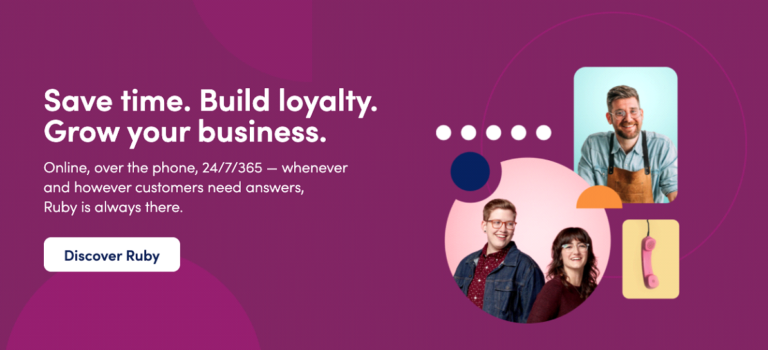
What action do you want people to take when they visit your website? Are there certain deals, services, or capabilities you want them to know about?
Convert visitors into leads by putting the right words, imagery, promotions, and resources in front of them. Effective CTAs entice people to take the next step—whether it’s calling your business, giving you their contact information, downloading content, checking out your products, learning more about your services, or engaging in another activity.
2. Landing pages
The most successful lead generation is often the most specific. It cultivates demand by offering a particular group of people a particular solution to a particular problem they face. For a family law attorney in northeast Texas looking to attract clients, for example, advertising as a “Dallas divorce lawyer” is probably more effective than advertising simply as a “lawyer.”
But creating a targeted ad is step one. Once someone clicks on the ad, where they end up matters. That’s where landing pages come in. Landing pages are specific pages built for users to “land” on after interacting with your ads. They can be designed with specific audiences’ intentions and buyer journeys in mind, so you can maximize your chances of converting the people you want to convert into leads.
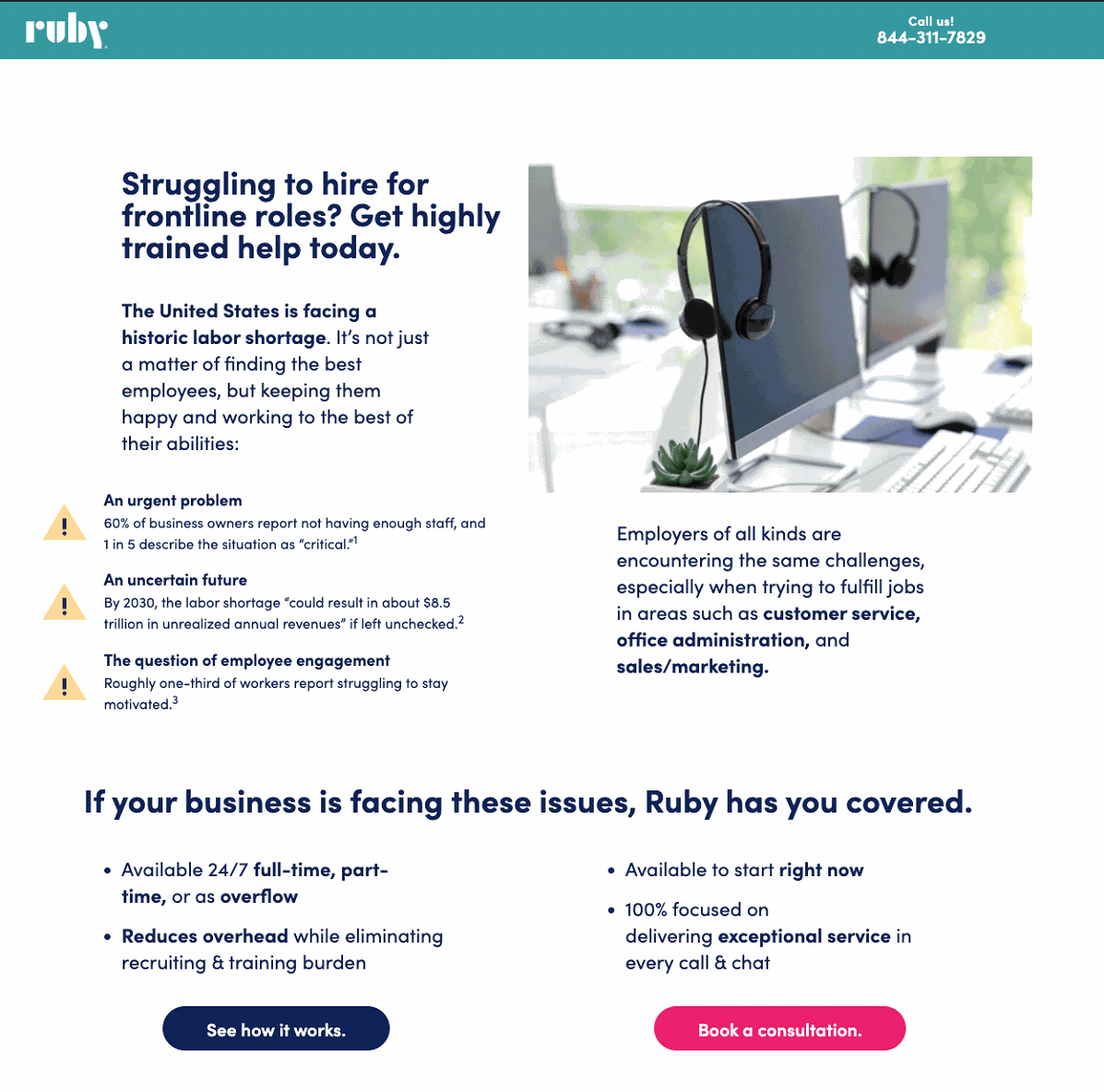
3. Forms
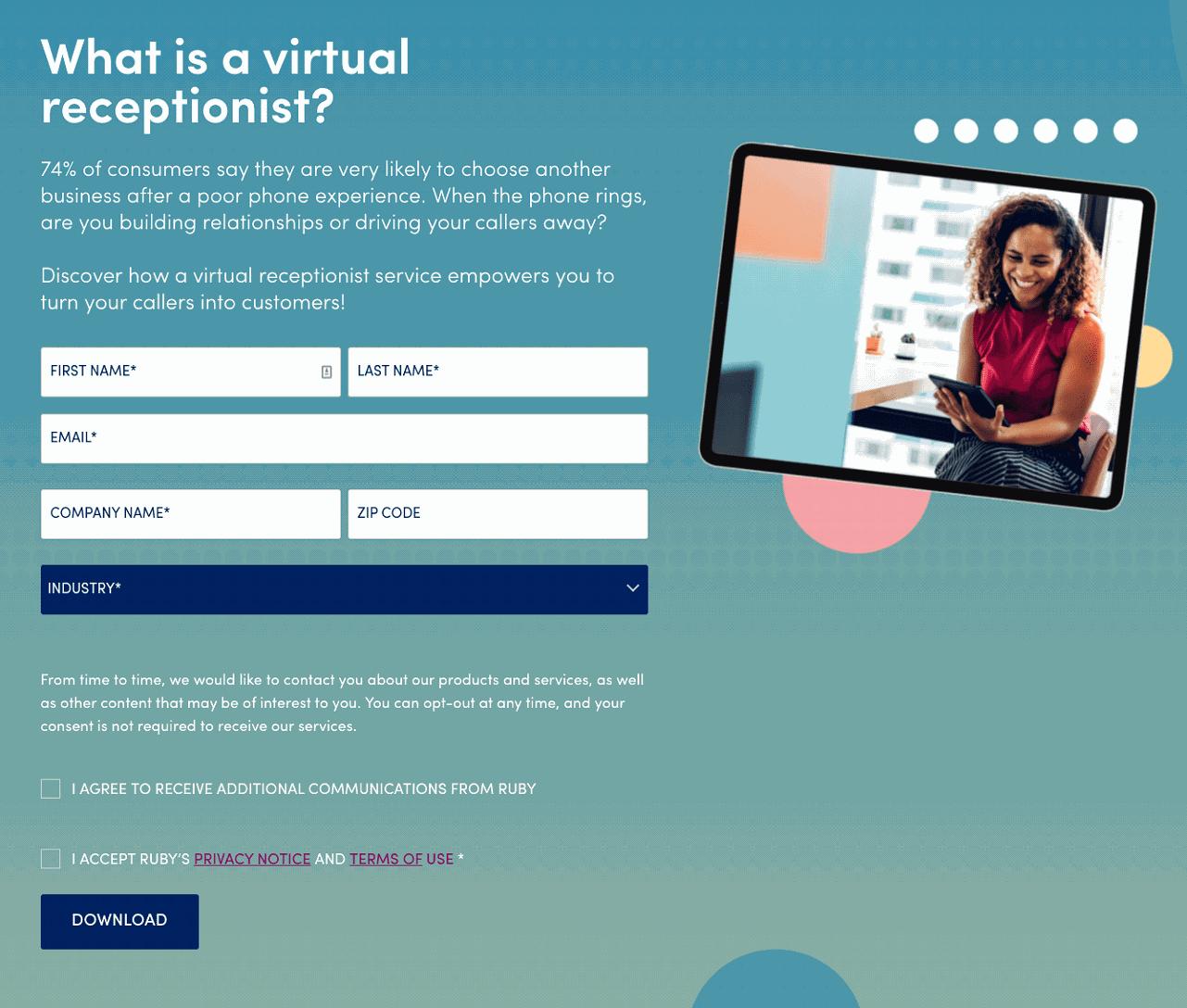
Lead generation is about more than drumming up general awareness of your products, services, or brand. It’s about pinpointing and connecting with the individual people who are actively interested in doing business with you. And to do that, you need to obtain their permission, contact information, and any other details that qualify them as a potential buyer.
Forms to the rescue! For many marketers, forms act as the first and most important lever in turning visitors into leads. They start the conversation between a business and a prospective customer or client.
A word of advice: keep your forms short and simple. Make it as easy as possible for your visitors to convert, and you’ll maximize the chances of conversion.
4. Live chat
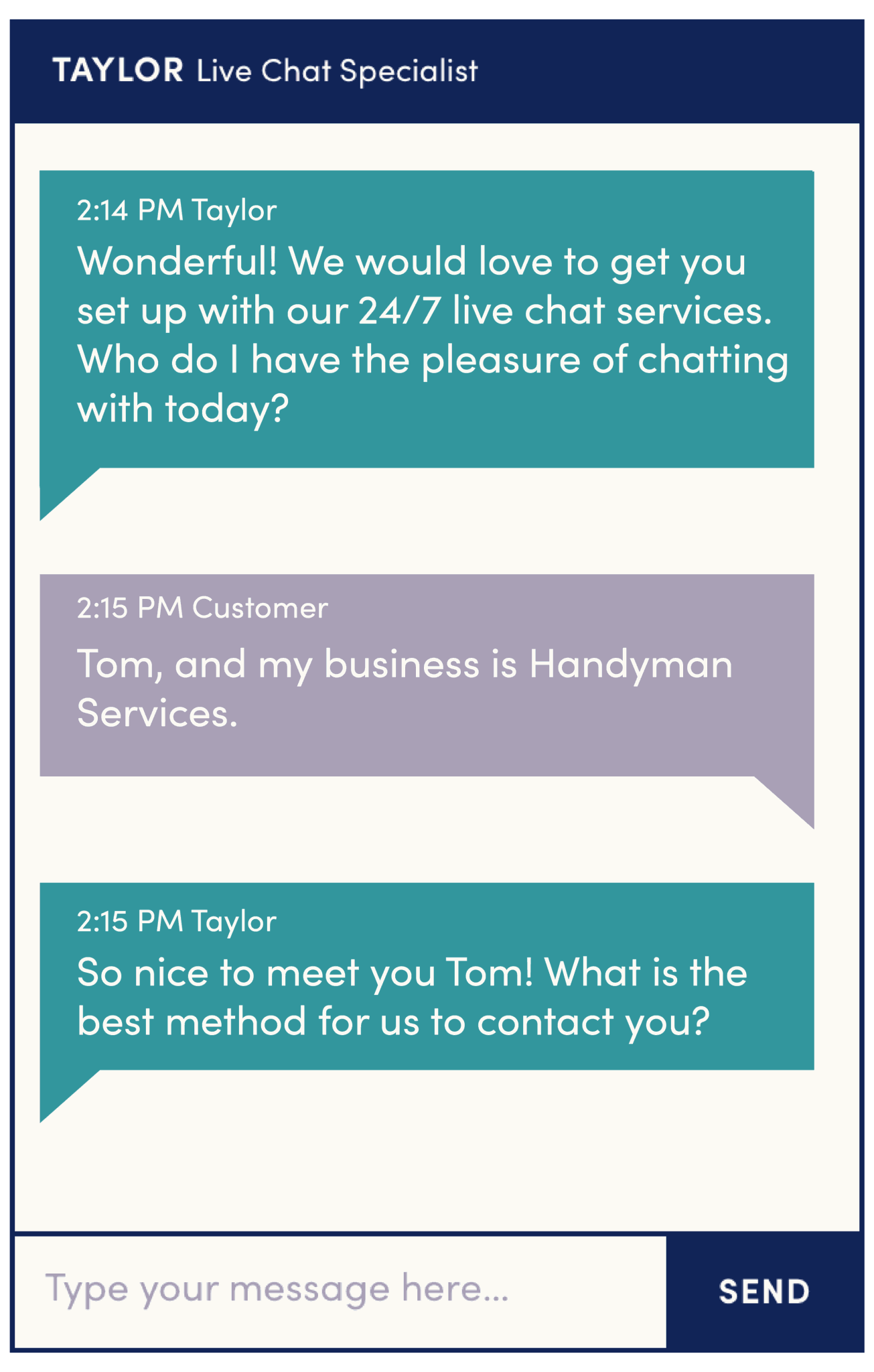
If your website is the digital equivalent of a physical storefront, live chat is comparable to a friendly representative at the front desk.
Did you know?
- Live chat is 4.6 times more likely than other channels to convert website visitors into customers.
- Approximately 42% of all customers prefer chat over other communication channels.
- Of customers who use chat, 82% report satisfaction with their experiences —the highest level of all customer service channels.
Businesses are increasingly using chat to learn about their website visitors, answer questions and address sales objections, offer help on demand, and more. (For a full rundown on using live chat as a marketing and sales tool, check out my article.)
These are just a few of the factors that determine your website’s capacity to generate leads for your business. Other considerations include page speed, navigation, user experience, mobile responsiveness, video content—the list goes on.
To learn more, download our ebook:
The new front door to your business.
How to start a podcast
By Tom Foster, Founder and CEO of Foster Web Marketing, and Host of the World of Marketing Podcast
Millions of people listen to podcasts every day. It’s how many of us indulge our interests, expand our knowledge, and broaden our worldview.
All kinds of businesses also use podcasting to drive leads and keep clients hooked on their brands—and it works! Plus, for a business, a podcast can be a great strategy for supporting other digital marketing efforts, as well as a valuable lead generation tactic unto itself.
The only problem is that podcasting is, well, harder than it looks—or sounds. And while the results can be deeply rewarding, you need to go into it knowing what you want to get out of it.
Trust me—I know from personal experience! Here are five tips I wish I had known before I started a podcast.
1. Get specific.
People new to podcasting often try to make their shows all things to all people. Meanwhile, the most successful podcasts aren’t afraid to be authentic and really get into niche ideas, insider tips, and other “deep cuts” that strongly appeal to a smaller (but highly engaged) audience.
To put it bluntly, too general is too boring. They say specificity is the soul of narrative. In a sea of over two million podcasts, the same is true for success in creating audio content.
So, identify a topic you can speak to frequently while adding your unique value. Come up with a consistent style for sound, music, and the visual branding of your podcast. excite you.
Put your personality into it, and don’t be afraid to talk about the things that genuinely excite you.
2. Let it marinate.
Podcasting is an exciting, sometimes adrenaline-pumping process, especially if you’re a host. While it can be tempting to get a podcast out into the world as soon as you’re finished recording or editing, the content (and your own well-being) will benefit from a little “marination” time.
Before you publish an episode, give yourself a day or two of space. When you go back in, you’ll be more likely to catch any little things you missed in the editing process, and you’ll get a more objective sense of the finished product.
3. Format dictates equipment.
Podcasting is an investment, particularly in terms of equipment. To keep your costs down and your scale reasonable, ask yourself the following kinds of questions:
- Will I present topics by myself, or do I primarily want to interview guests?
- Will I do audio-only, or do I want a video component?
- Do I want to get the audience involved live?
- Which platforms—like YouTube, Spotify, Apple Podcasts, etc.—will I publish on?
Once you have the format nailed down, you’ll have a clear idea of the type of equipment, space, and setup you need to invest in.
4. Give guests what they need to be great.
Remember that podcast guests are your guests—think of them as a guest in your home or office. It’s your responsibility to make sure your guests feel comfortable and have everything they need to give a great interview. That includes prepping them for recording, letting them know what will be discussed, and even providing an outline or list of potential questions.
When your guests are prepared and confident, you get a smoother podcast that sounds more intelligent, intentional, and professional.
5. Consider the listener’s experience throughout.
The best podcasts are created and optimized for their listeners. Consider your audience’s expectations and attention span. Most successful podcasts are longer than 20 minutes but rarely over an hour. If yours runs on the long end, be sure to break it up by occasionally teasing the next point, briefly reintroducing the guest, or building up the value of a promotion, offer, or contest. These built-in pauses give listeners a chance to reorient, keeping them engaged and tuned in throughout the show.
Last, keep in mind that no podcast is an island. Podcasts aren’t just a channel for you to talk about topics you care about. They’re opportunities to create connections based on mutual interests.
So, make it easy for people to find you and tune in. Become a guest on other podcasts you like. Work with marketing and video partners that can handle the parts you don’t want to deal with. It’s these kinds of connections that can tap you into new audiences and ultimately create a stronger lead flow from your podcast back to your business.
Live video streaming 101
By PJ Taei, Founder and President of Uscreen
With more than 2 billion active users, the power and reach of YouTube are unparalleled in the world of video sharing (and the world of cute cat compilations.)
So, how can you take advantage of this massive audience and get them to engage with your business?
One increasingly popular way is through live streaming. In addition to sharing prerecorded and edited content, going live with your audience can help you create even more meaningful connections and make your brand seem more authentic. For certain businesses, it can also be one of the most effective ways to build an audience and generate leads—or even make some extra income through monetization.
This topic could fill its own ebook (or multiple ebooks). But if you’re looking for inspiration for the type of content you can live stream, we’ve put together a quick overview with four tried and true formats and tips to engage your audience:
4 types of live streams you can host
When you decide your business is ready to go live on YouTube, you need to choose the right format for your needs.
The industry you’re in, your target audience, and what you hope to achieve from your YouTube content will all be factors when choosing how you’re going to go live. Here are four different formats you can use for your live content to get your audience engaging with you:
1. Office hours and Q&A: Invite viewers to ask questions and engage in conversation.
2. Webinars: Present on a topic in which you have expertise.
3. Conferences: Open in-person events up to your virtual audience—or make events entirely digital.
4. Commentary on news and noteworthy events: Offer perspectives and insights about the latest happenings in your industry or community. (For maximum engagement and lead generation, make a routine of it!)
3 tips for hosting successful live events
Tapping into a new creative way to market your business is always exciting, even when there are risks involved.
Testing what works to engage your audience is important, but it’s always worthwhile getting a head start with some tips so you hit the ground running.
Here are our top three tips to get your YouTube campaign off to a successful start:
1. Promote your live streams.
Whether you’re just learning about managing your social media presence or you’re a seasoned pro, you’ll understand how important it is to promote new content to your existing audience, as we do at Uscreen.
Any channels that you already use to communicate with your audience (such as your blog or newsletter) help you build awareness around your live streams. Inviting question submissions ahead of time and encouraging people to subscribe to your channel to get notifications will also ensure that people have a strong incentive to tune in.
2. Encourage real-time participation.
Once you have your audience watching your live stream, you need to make them feel like they’re part of the experience!
A simple and effective way to do this is to ask them to participate in the live chat feature that YouTube offers, which allows you to answer their questions in real time.
Other techniques you can use to get your audience using the chat is to invite them to leave a comment with their location or to confirm if they’re a new viewer or a long-term fan. This can give you an insight into your audience as well as information to refer to during your stream if needed.
3. Be consistent.
Hosting your YouTube live streams regularly and consistently is a great way to build up your audience. Most of your viewers will have a schedule they stick to, so time your live stream accordingly in order to claim a regular spot on their calendar and begin to build a following.
Ensure that people tune in for regular updates by keeping content consistent as well.
And that’s our brief guide to using the power of live streaming to connect with your audience. By choosing the right format, telling your audience about your live event, and engaging with them through chat, you’ll be able to form a deeper connection with your viewers—and generate some leads while you’re at it.
Lead generation tactics for your industry
By Joe Martin, VP of Marketing at Scorpion
Digital marketing enables you to generate leads in many ways, including driving traffic to expert content on your website, blog, social media pages, and more. As covered in depth in the previous sections, online lead generation refers to a range of tactics, campaigns, and strategies, whether paid or organic. Regardless of your business or industry, it’s necessary to use the right lead generation tools and keep your users’ journey at the forefront of your mind.
At Scorpion, we have helped many small, medium, and large multi-location businesses grow with different tactics specific to their industry, location, and challenges. Here are some examples of the success we helped clients achieve across legal, home services, and healthcare to help serve as a guide.
Generating leads in the legal industry
Efficient lead generation and management for law firms are critical, given that the intense competition in this industry can result in a high cost per lead. Therefore, it’s essential to leverage a diversified strategy that markets your message across multiple channels to take advantage of those with less expensive costs.

One of the most effective and cost-friendly ways to generate leads for your law firm is by curating a solid social media presence. Conversion ads establish your practice’s credibility and help your visitors understand the services you offer.
Scorpion’s clients have seen this play out by directing users to a landing page from Facebook to fill out a contact form. Using this conversion approach can decrease your average cost per lead and result in much greater lead quality. This strategy effectively gains higher-quality leads because it includes several educational touchpoints to help qualify the lead. The targeted ads, landing page, and contact form submission are all steps that require the customer to move through the journey.
At Scorpion, we used this approach for client Arnold & Itkin. We first set a clear goal for the social content, then focused on the type of content and posting schedule. Through this approach, we saw a 16.5% increase in good leads—clients that had a case applicable to their practice. Moreover, this influx happened even though the country was freshly on lockdown due to the COVID-19 pandemic.
Generating leads in the home services industry

When converting and managing leads in home services, some of the best lead conversion tactics are forms of content marketing—instructional videos, blog posts, and ebooks written with the homeowner in mind.
For example, publishing videos educating customers on how to take care of their homes provides long-term value for your audience while increasing your authority as a trusted expert. You can then promote these videos using Facebook’s marketing campaign, driving users to your website to learn more.
Scorpion utilized a three-part marketing campaign with one large multi-location franchise brand with a presence across the US. We first gathered relevant data about the key demographic, followed by a Facebook traffic campaign driving users to landing pages designed to promote form submissions and phone calls. We then led a “Facebook Lead Generation” campaign that remarketed to relevant users, prompting them to follow through with their initial interest. These actions resulted in an 82% decrease in cost per lead over a three-month period, which boosted their ROI significantly.
Generating leads in the healthcare industry
As the healthcare industry shifts to meet modern patients online, there are many trends that can go a long way in generating quality leads—Facebook promotions, Instagram posts, and leveraging website highlights.
For one Scorpion client—a fertility center located in the Southeast region of the US—we worked on content marketing techniques in all three of these areas:
- By focusing our Facebook promotions on a specific outreach (like National Fertility Week), our client reached an audience of almost 4,000 with promotional video content and received more than 600 engagements.
- In the same vein, a Q&A with one of the organization’s doctors reached nearly 3,000 people and gave the client insight into the demographics of their top viewers.
- And through these same promotions, Instagram stats increased by 2.88%.

What’s next?
Congratulations—you’ve learned the basics of lead generation! You understand how it fits into your overall marketing and business strategies. You know who your leads are and how to attract them. And you’re now familiar with multiple proven lead generation tactics, as well as what kinds of approaches are most effective for various industries.
So, what happens next? Well, just as there’s no such thing as spontaneous lead generation, leads don’t simply become your next customers or clients automatically. You need to qualify, nurture, and convert them.
Qualification, as we’ve touched on a bit in this ebook, is the process of determining whether a lead is the right kind of customer or client for your business. Depending on what you do and how you operate, you may need to make sure your leads live in a certain location or have the right budget, for instance. Scorpion’s results for clients, for example, demonstrate the firm’s thorough understanding of how to target and attract qualified leads.
Nurturing means engaging with and educating your leads over time. This is often essential for earning their trust, building relationships with them, motivating them to act, and helping them make informed buying decisions. Content marketing, newsletters, live video streaming, and even podcasts are all effective ways to nurture leads.
Conversion is the crucial step in making a sale—it’s the moment a lead becomes a real customer or client. As many of our contributors mentioned over the previous pages, well-designed forms with appealing CTAs are critical for converting leads.
Questions to ask
To make the most of the leads you generate, you’ll need a game plan and tools for each of these processes. If you’re not sure if your business is ready to handle leads, or if your approach is optimized, here are a few questions to consider:
- What’s the size of your sales team? Do you have one or more salespeople, or is it up to you or another member of your organization to wear the sales hat from time to time? If you lack a dedicated sales function in your business, consider outsourcing or automating as much as possible. Customer relationship management (CRM) software such as Salesforce, Zoho, and Zendesk can be an invaluable tool for a team of any size.
- What information do you need to qualify your leads? Do you need to know if they can afford your products or services? What about the nature or urgency of their needs? What do certain behaviors (such as downloading a piece of content or visiting your site for the fifth time) indicate about their readiness to have a sales conversation?
- What channels are best for communicating with your leads? Are they most receptive over email, the phone, social media, live chat, or another channel or combination of channels?
- What kind of marketing content can you use to nurture your leads? What articles, videos, graphics, guides, and other kinds of content can you leverage to educate your leads, demonstrate your value to them, and compel them to take action?
Dos and don’ts for handling leads
Do…
- Reach out to your new leads quickly.
- Categorize and keep track of your leads.
- Send relevant, informative content to your leads.
- Keep communication with leads personal and conversational.
- Listen, ask questions, and take an active role in learning about your leads.
- Know when to move on when a lead isn’t interested.
Don’t…
- Rely on cold calls (they’re one of the least effective sales strategies).
- Assume what your leads do or don’t know about your business.
- Read word-for-word from sales scripts (use them as guides for conversations instead).
- Give up after reaching out to a lead once and not getting a response.
- Reach out more than five times to a lead who hasn’t expressed further interest.

